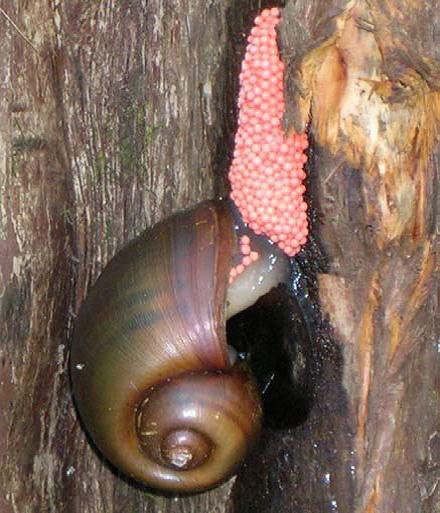(Pomacea canaliculata)
General Description
 Channeled apple snail laying an egg mass, which typically contains between 200 – 600 bright pink eggs. Photo by Katasha Cornwell, Florida Department of Transportation.
Channeled apple snail laying an egg mass, which typically contains between 200 – 600 bright pink eggs. Photo by Katasha Cornwell, Florida Department of Transportation.
Channeled apple snails (CAS) are large, freshwater snails that grow to over 3 inches in length. Their shells have 5 to 6 whorls separated by a deep groove or “channel”. Shell coloration of channeled apple snails is highly variable, but normally includes bands of brown, black, and yellowish-tan, although albino and gold color variations do exist. CAS possess both a gill and a lung, which allows them to “breathe” in and out of water, and have an operculum, or lid, on their shell to avoid desiccation during dry periods. CAS lay egg masses, typically containing 200 – 600 bright pink eggs, on solid structures such as rocks, walls, logs, and vegetation above the water surface. Without genetic testing, they are physically indistinguishable from the slightly larger, also non-native, island apple snail (P. insularum), which has historically been confused with the CAS.
Current Distribution
CAS have been in California since at least 1997, and are now present in Contra Costa, Riverside, San Diego, Los Angeles, and Kern counties. They are established in Hawaii, Yuma and Maricopa counties in Arizona, and one location in Northern Florida. A population was discovered in 2016 in Twin Falls, ID. The similar island apple snail (IAS) is established in Florida (previously believed to be CAS), Texas, Alabama, Georgia, and Louisiana. Individuals have also been collected in Indiana, Ohio, and North Carolina, but whether they were CAS or IAS, is unclear.
Habitat Preference
CAS occur in lakes, ponds, rivers, ditches, wetlands, and agricultural areas, such as rice and taro fields. They are native to the Amazon and Plata basins of South America, therefore well adapted to tropical climates and tolerant of a wide variety of environmental conditions, including salinity, low oxygen, and nutrient enrichment. They tend to stay submerged during the day, hidden among vegetation below the surface, and are active at night, leaving the water to search for fresh vegetation to feed on. Movement and activity of the CAS is reduced by low temperatures, but it has a greater cold tolerance than other apple snails, with greater potential to establish further north.
Pathways
CAS were introduced to southeast Asia in 1980 and Hawaii in 1989 to develop gourmet food industries. The markets failed to develop and the snails escaped or were released into the wild. Channeled apple snails were also intentionally introduced to the United States for the aquarium trade; they have been developed as a domestic aquarium snail and distributed through pet store sales. They also may have been accidentally introduced and subsequently distributed via the nursery trade as eggs or small juveniles attached to aquatic plants. Also contributing to their spread, has been the intentional introductions to uncontained wetlands with the intent of harvesting as a food resource. CAS can disperse via release by aquarium owners, movement across land, and floating in water currents and floods. The CAS is on California’s list of restricted animals and cannot be imported, transported, or possessed without a permit.
Impacts
CAS are voracious consumers of aquatic plants. They have become major agricultural pests where introduced, impacting rice production in southeast Asia and the Philippines, and taro production in Hawaii. If their distribution increased in California, CAS could threaten the rice crops in California’s Central Valley. CAS can impact wetlands and other freshwater ecosystems by modifying plant community structure and nutrient cycling, and may also compete with native snails and other invertebrates for food and space. CAS can carry and transmit the Rat lungworm (Angiostrongylus cantonensis), which can infect humans that consume undercooked or raw snails and cause a very fatal form of meningitis.
Actions Taken if Found
If this species is found in California, do not release it. Preserve (freeze) the specimen and immediately
contact the CDFW Invasive Species Program, or email us at Invasives@wildlife.ca.gov, or (866) 440-9530.
Control Options
Preventing the spread of CAS into new locations is the most effective and efficient management option. Never release unwanted pets or aquarium plants and animals into the wild!
If CAS are found in a new location in California, hand removal, crushing, or spraying egg masses with water is advised.
- Hand remove any adults and egg masses found. During the day, adults are typically submerged in water. At night, adults feed and lay eggs on exposed, dry vegetation.
- Crushing egg masses and adults is more effective than knocking egg masses into the water, which ultimately suffocates and kills the eggs.
- Spraying egg masses with a powerful stream of water is an effective way to suppress egg masses, particularly those in areas hard to reach. A boat outfitted with sprayers is an ideal approach.
Once a population has established in a new area, intensive hand removal and egg mass suppression efforts may be an effective means of control, but likely cannot remove the population entirely.